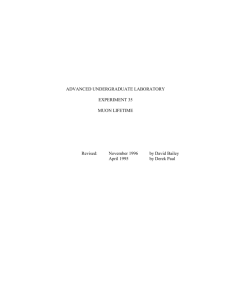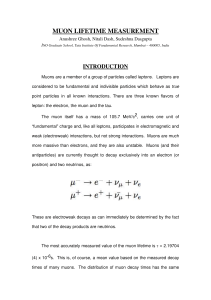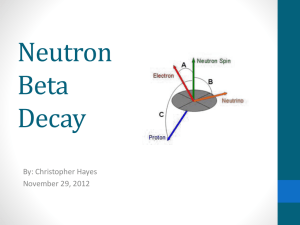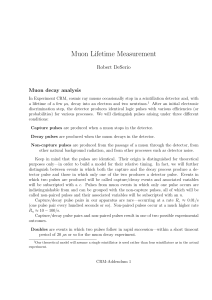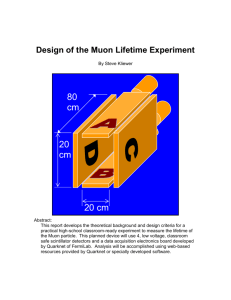Experiment B21
advertisement
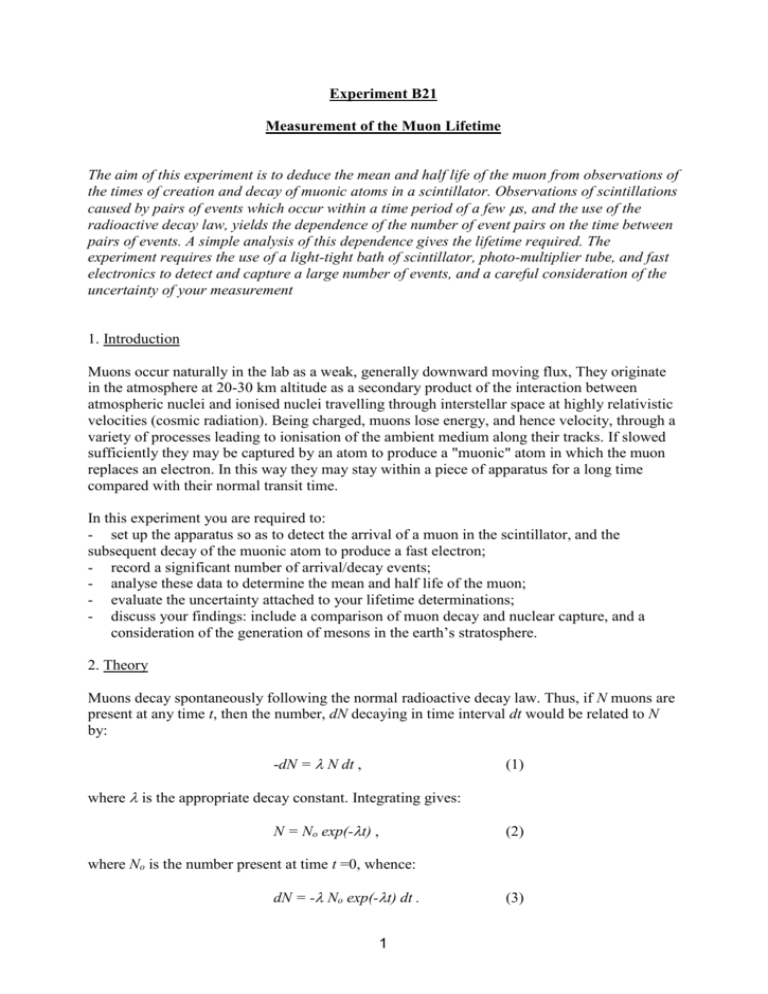
Experiment B21 Measurement of the Muon Lifetime The aim of this experiment is to deduce the mean and half life of the muon from observations of the times of creation and decay of muonic atoms in a scintillator. Observations of scintillations caused by pairs of events which occur within a time period of a few s, and the use of the radioactive decay law, yields the dependence of the number of event pairs on the time between pairs of events. A simple analysis of this dependence gives the lifetime required. The experiment requires the use of a light-tight bath of scintillator, photo-multiplier tube, and fast electronics to detect and capture a large number of events, and a careful consideration of the uncertainty of your measurement 1. Introduction Muons occur naturally in the lab as a weak, generally downward moving flux, They originate in the atmosphere at 20-30 km altitude as a secondary product of the interaction between atmospheric nuclei and ionised nuclei travelling through interstellar space at highly relativistic velocities (cosmic radiation). Being charged, muons lose energy, and hence velocity, through a variety of processes leading to ionisation of the ambient medium along their tracks. If slowed sufficiently they may be captured by an atom to produce a "muonic" atom in which the muon replaces an electron. In this way they may stay within a piece of apparatus for a long time compared with their normal transit time. In this experiment you are required to: - set up the apparatus so as to detect the arrival of a muon in the scintillator, and the subsequent decay of the muonic atom to produce a fast electron; - record a significant number of arrival/decay events; - analyse these data to determine the mean and half life of the muon; - evaluate the uncertainty attached to your lifetime determinations; - discuss your findings: include a comparison of muon decay and nuclear capture, and a consideration of the generation of mesons in the earth’s stratosphere. 2. Theory Muons decay spontaneously following the normal radioactive decay law. Thus, if N muons are present at any time t, then the number, dN decaying in time interval dt would be related to N by: -dN = N dt , (1) where is the appropriate decay constant. Integrating gives: N = No exp(-t) , (2) where No is the number present at time t =0, whence: dN = - No exp(-t) dt . 1 (3) Clearly if No =1, dN would be equivalent to the probability of decay. The decay constant, , is related to the "mean life" and the "half life"; see for example H. Semat, “Introduction to Atomic and Nuclear Physics", p.304. A suitable re-arrangement of eq. (3) will enable a straight line to be fitted to the experimental histogram of number of events against time interval, so that the gradient yields the decay constant, . 3. Experimental procedures You are provided with a light-tight, metal box (at earth potential) containing a perspex tank filled with an organic liquid scintillator (POPOP1). On top of this tank is a very sensitive photomultiplier tube and its associated components. The scintillator emits a flash of light whenever a fast charged particle passes through the tank. The photo multiplier converts this flash into a few photoelectrons at a photocathode and these are multiplied through a cascade process involving acceleration, impact and re-emission at a number of electrodes arranged as a series of plane parallel “Venetian blinds" called "dynodes". The resulting pulse of ~109 electrons is collected at an anode supplied through a resistor from a high voltage source, which also biases the intermediate dynodes via a chain of resistors. The resulting negative going exponential tail pulse at the anode is processed by the two electronics boxes (the discriminator and the converter) to give a fixed width, negative going, fast TTL pulse of 50 impedance, suitable for connecting to the external instrumentation. The amplitude of the negative pulse driving the discriminator is dependent on the intensity of the light flash and the multiplication factor (gain) of the photomultiplier, the latter being very dependent on the value of the high voltage supplied to it. Thus as the high voltage is increased from a low value, the negative pulse amplitude will increase to the point where the largest will trigger the discriminator. Negative TTL pulses will start to appear at the output of the converter box at this point (duration 1ns). Further increase in the high voltage will lead to the registration of weaker light flashes hence producing a faster pulse rate. Eventually, even the internal random noise events in the photomultiplier will begin to register and the pulse rate may rise rapidly. You will find correct operation of the PMT in the region of + 1, 675V, but you should investigate how the count rate varies with applied voltage over a reasonable range, but not exceeding 2kV, and discover whether a "plateau" exists in the count rate vs. voltage curve. Consider why the existence of such a plateau might be useful. The computer based counter-timer provided includes the facility to display a continuously updated mean value of the measurement being made (in this case frequency). You may access this facility via the virtual front panel provided. The name of the file is C:\GTI\VIRT.EXE. The birth and death of the muonic atoms will be registered as two related flashes, one as the muon enters the tank and a second as the muon in the muonic atom decays, producing a fast electron2. These events are likely to occur at the rate of one or two atoms per minute, with the flash pairs separated by a few microseconds. They may be identified with patience by viewing 1, 4-Di-2-(5-phenyloxazolyl) benzene, C24 H16 N2 02 suspended in liquid paraffin. In fact there are two possible decay modes. One involving muon decay: - e- + + , and one involving capture by the nucleus: - + p n + . Try to assess the relative probabilities of these by background reading in the library. 2 1 2 the pulses on a fast oscilloscope. It is the statistics of these time intervals between related pairs of events which you will need to record. The light- tight box has two connectors on its upper panel. One is for the high voltage input, the other provides the pulses from the anode of the PMT. A high voltage supply, which also provides the low voltages needed for the two signal processing boxes is supplied together with any special cables required. Ignore the focus control, leaving it set at approximately half rotation: it optimises the photoelectron collection in the photomultiplier but the collection is always good enough for this experiment. All connections should be correctly terminated with 50 . Use the oscilloscope provided to observe the pulses from the PMT using the fast amplifier with a 50 input. The settings for the correct triggering of the timebase are not straightforward, and will require some experimentation. A demonstrator or technician should be contacted if difficulty is encountered. When you think you have identified the pulses, connect them to the signal processing electronics, consisting of a variable rf attenuator (to increase the effective range of threshold voltages available), a discriminator and a TTL converter. Use the oscilloscope to observe the output from these. With zero attenuation the discriminator is so sensitive that even random noise will trigger an output. Increase the level of attenuation to a point (~30dB) when only real event pulses are registered. The trigger light on the oscilloscope should be flashing at an irregular frequency. Connect these pulses to the 'A' input of the computer based counter-timer and use the virtual front panel to configure the instrument to measure the frequency of negative-going pulses on a 50 line. Use the statistics menu to display the mean average value over a substantial number of measurements, and plot the V vs. f curve for the PMT. Identify any plateau region and set the high voltage to the centre of that region: any variation of V will have minimum effect on the gain of the PMT at this setting. Note the count rate (including noise) at the voltage V you choose. You will need it later to estimate the random coincidence rate. Use the BASIC program provided to measure the time intervals between pulses, discarding any longer than 10S and sorting them into time buckets of 1-2; 2-3; 3-4...........9-10 S. This program sets up the timer-counter to measure single periods between negative-going edges on input A set to 50 . It is contained in the BASIC samples folder in the GTI directory and is called MUON.BAS. Collect a large data set and transfer the results to a spreadsheet, statistics/graph package such as "Statworks", "Cricketgraph" or "Excel". The package selected must be able to carry out a least squares fit and calculate natural logarithms. Use this software to analyse and display your data and to produce hard copy. You may like to check the correct operation of the "time bucket" counter using a pulse generator in double pulse mode (or two pulse generators) to simulate the various intervals expected. 4. Analysis The results should be presented in the form of a histogram. First, produce a trial histogram on a limited set of data (perhaps a few hours of observations), to get a "feel" for the statistics and the appropriate time buckets, dt. Proceed with the full histogram, remembering that you need to obtain the slope of an eventual fitted line and Poisson statistics apply: consequently, the uncertainty will decrease as the number of observations is increased. Investigate and comment on any anomalies in the shape of the histogram and deduce the effect of any chance pairs produced by the close association of random single events. Report a best estimate of half life 3 and mean lifetime. Make an estimate of the uncertainty in the values you obtain, explaining clearly how you obtain the uncertainty; remember that Poisson statistics apply. Explain why your half-life is compatible with the generation of mesons at 20-30 km altitude. 5. The Report Your report should include an abstract; an introduction which explains the background to the experiment; a description of the experimental set up; the data and their analysis (including a thorough error analysis); and a conclusion section in which your result, with quoted uncertainty, is presented and discussed (see section 4 above). Graphs and tables of data should be included. 4

